#Potato Starch
Text
I had a flat-earther science teacher who brought in Ellen to prove potato starch wasn't carbon based by putting an apple into a beaker full of Coca Cola.
3K notes
·
View notes
Text

Apple Butter Snickerdoodle Cookies (Vegan + GF)
#apple butter#snickerdoodles#cookies#vegan#gluten free#egg free#dairy free#cinnamon#autumn#winter#halloween#christmas#recipe#apple#fruit#potato starch#almond flour#nuts#almond#tapioca free#minimalistbaker
211 notes
·
View notes
Text

Pineapple Coconut Cream Puff (Vegan & Gluten-Free)
#vegan#gluten free#desserts#cream puffs#pineapple#coconut cream#cashews#lemon#oat flour#almond flour#potato starch#rice flour#coconut flour#psyllium husk#plant milk#vegan butter#apple cider vinegar
128 notes
·
View notes
Text

Passover Lemon Meringue Pie (via Truffles and Trends)
#gluten free#gf food#gluten free foods#dairy free#dessert#soy free#grain free#passover#lemon#potato starch#almond flour#trufflesandtrends#kosher
8 notes
·
View notes
Text

“แป้งทำอาหาร" มีกี่ชนิด
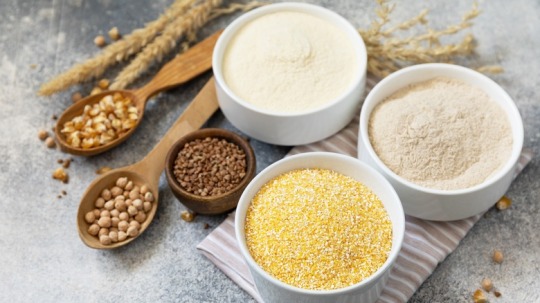
“แป้งทำอาหาร" มีกี่ชนิด
แป้งทำอาหาร มีกี่ชนิด แป้งชนิดไหนเหมาะจะนำมาทำอะไร เราไปดูกันเลยค่ะ
1. แป้งข้าวเจ้า (Rice flour)
แป้งข้าวเจ้า หรือบางทีก็เรียกว่า แป้งญวณ ทำมาจาก เมล็ดข้าวจ้าว จับแล้วสากมือ เมื่อใช้มือสัมผัสจะมีความหยาบเล็กน้อย แต่สากมือกว่าแป้งสาลี พอทำให้สุกแล้วตัวแป้งจะมีสีขาวขุ่น จับตัวกันเป็นก้อน เหมาะสำหรับนำไปทำอาหารที่ต้องการความอยู่ตัว เนื้อขนมจะมีความแข็งร่วน
เมนูที่ทำจากแป้งข้าวจ้าว ได้แก่ ขนมกล้วย ขนมเบื้อง ขนมดอกจอก ลอดช่อง ขนม ขนมตาล ขนมชั้น ขนมถ้วยตะไล (ขนมถ้วย) ซึ่งแป้งข้าวเจ้าถือว่าเป็นแป้งที่ถูกนำมาทำขนมไทยมากที่สุด
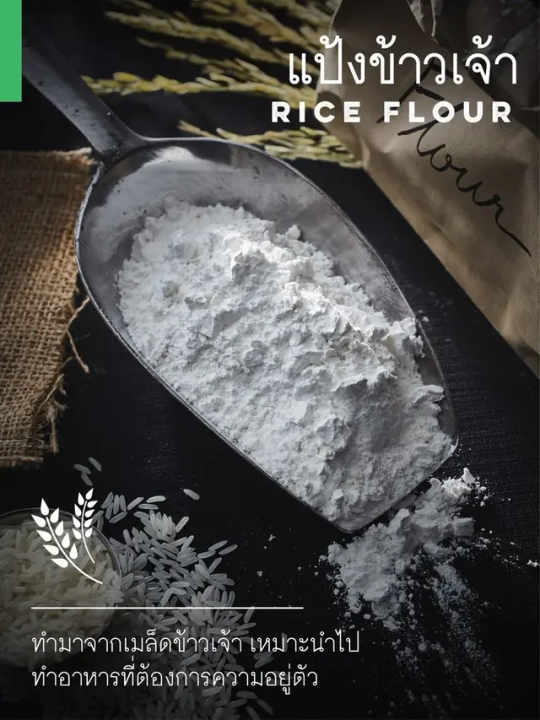
แป้งข้าวเจ้า

เมนูที่ทำจากแป้งข้าวจ้าว
2. แป้งข้าวเหนียว (Glutinous flour)
แป้งข้าวเหนียว ทำมาจากเมล็ดข้าวเหนียว มีลักษณะคล้าย ๆ กับแป้งข้าวเจ้าคือเป็นผงสีขาวๆ เมื่อใช้มือสัมผัสจะมีความหยาบเล็กน้อยกว่าแป้งข้าวเจ้า พอทำให้สุกแล้วตัวแป้งจะมีสีขาวขุ่นข้น มีความเหนียว
เมนูที่ทำจากแป้งข้าวเหนียว ได้แก่ ขนมต้ม บัวลอย ขนมถั่วแปบ ข้าวเหนียวตัด ขนมเทียน ขนมเข่ง ข้าวเหนียวเปียก ขนมบ้าบิ่น ขนมโก๋ แป้งจี่ ขนมโค ซึ่งบางเมนูที่ไม่ต้องการความเหนียวมากนักก็ให้ผสมแป้งข้าวเจ้าลงไปค่ะ

แป้งข้าวเหนียว

เมนูที่ทำจากแป้งข้าวเหนียว
3. แป้งมันสำปะหลัง (Tapioca starch / Cassava starch)
แป้งมันสำปะหลังหรือแป้งมัน บางทีก็เรียกว่า แป้งมันสิงคโปร์ ทำมาจาก หัวมันสำปะหลัง เป็นผงสีขาว เนื้อแป้งมีความละเอียด ลื่นมือ เมื่อถูกทำให้สุกแล้วตัวแป้งจะเหนียวหนืด มีสีใส เหมาะกับการนำไปทำอาหารที่มีความเหนียวแต่ใสและดูขึ้นเงา แต่ข้อเสียของแป้งมันสำปะหลังคือ เมื่อถูกทำให้เย็นลงจะคืนตัวง่ายมาก จึงมีการนำแป้งชนิดอื่นมาผสมเพื่อทำให้ขนมมีความเหนียวนุ่มขึ้น
เมนูที่ทำจากแป้งมันสำปะหลัง ได้แก่ ลอดช่องสิงโปร์ เต้าส่วน บัวลอย ครองแครงแก้ว ทับทิมกรอบ ขนมชั้น ขนมปลากริมไข่เต่า เป็นต้น ส่วนอาหารคาว ได้แก่ กุยช่ายทอดหรือหอยทอด ซึ่งต้องผสมแป้งผสมแป้งสาลีลงไปเพื่อให้ได้ความกรอบและนุ่ม เพราะถ้าใช้แป้งมันสำปะหลังอย่างเดียวอาหารทอดจะไม่กรอบ
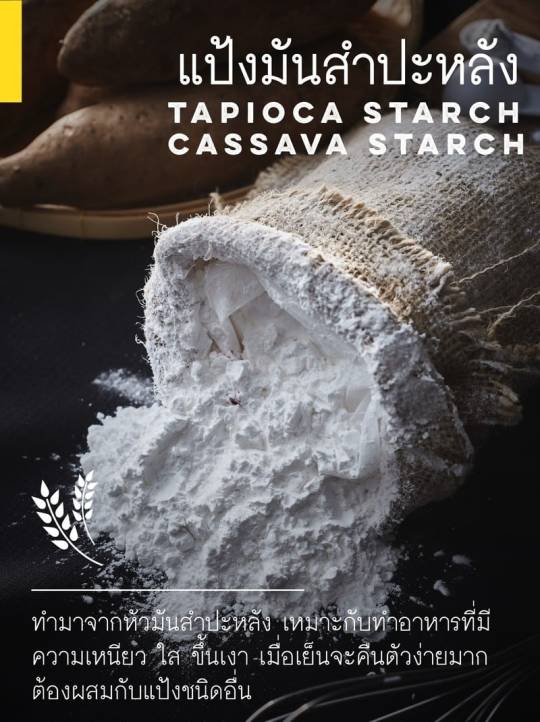
แป้งมันสำปะหลังหรือแป้งมัน

เมนูที่ทำจากแป้งมันสำปะหลัง
4.1. แป้งข้าวโพด บดละเอียด (Corn starch)
แป้งข้าวโพด บดละเอียด ทำมาจากเมล็ดข้าวโพด เป็นผงสีขาวเหลืองนวล เนื้อแป้งเนียนและลื่นมือ ข้อดีของแป้งข้าวโพดคือ เมื่อถูกทำให้สุกแล้วเนื้อแป้งจะข้นเหนียว มีความใสและไม่คืนตัว
เมนูที่ทำจากแป้งข้าวโพด บดละเอียด ได้แก่ ราดหน้า ไส้ขนม รวมถึงซอสต่างๆ ด้วย
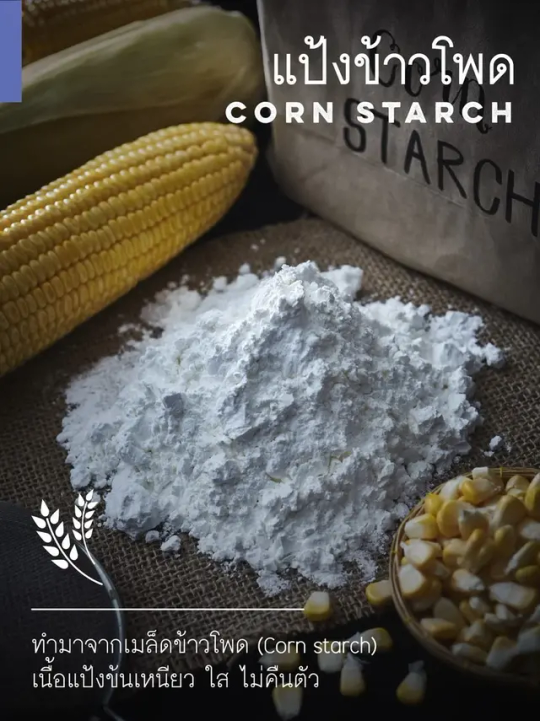
แป้งข้าวโพด บดละเอียด
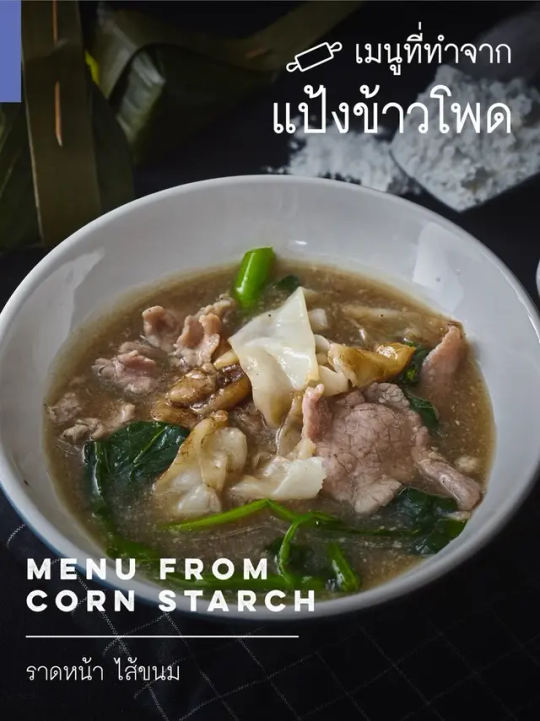
เมนูที่ทำจากแป้งข้าวโพด บดละเอียด
4.2. แป้งข้าวโพด บดหยาบ (Corn Meal)
แป้งข้าวโพด บดหยาบ ทำมาจากเมล็ดข้าวโพดบด แต่ไม่ละเอียดเท่ากับ Corn starch เนื้อจะหยาบกว่า
เมนูที่ทำจากแป้งข้าวโพด บดหยาบ (Corn Meal) ได้แก่ มัฟฟิน และขนม
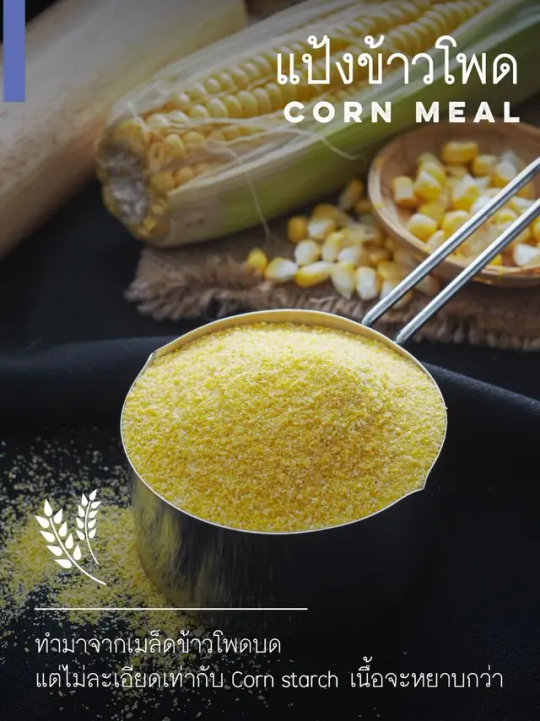
แป้งข้าวโพด บดหยาบ

เมนูที่ทำจากแป้งข้าวโพด บดหยาบ
5. แป้งเท้ายายม่อม (Arrowroot Starch)
แป้งเท้ายายม่อม ทำมาจากหัวมันเท้ายายม่อม เป็นแป้งที่มีราคาสูงกว่าแป้งชนิดอื่นๆ เพราะหัวมันเท้ายายม่อมนั้นสามารถเก็บเกียวได้แค่ปีละครั้ง แถมวิธีการทำแป้งก็ค่อนข้างยุ่งยากซับซ้อน ตัวแป้งจะมีลักษณะเป็นเมล็ดสี่เหลี่ยมเล็กๆ สีขาว เนื้อสัมผัสจะมีความหยาบมากเมื่อเทียบกับแป้งชนิดอื่นๆ ก่อนนำมาทำอาหารต้องนำมาบดให้ละเอียดและร่อนเสียก่อน เมื่อโดนความร้อนจนสุกแล้ว ตัวแป้งจะมีลักษณะข้น เหนียวหนืดและมีความใส นิยมนำมาผสมกับแป้งชนิดอื่นแล้วนำไปทำอาหารที่ต้องการความข้นเหนียวและมันวาว
เมนูที่ทำจากแป้งเท้ายายม่อม ได้แก่ ขนมชั้น ขนมเปียกปูน ขนมน้ำดอกไม้ ลอดช่องต่างๆ แต่จะต้องผสมกับแป้งข้าวเจ้าลงไปด้วย
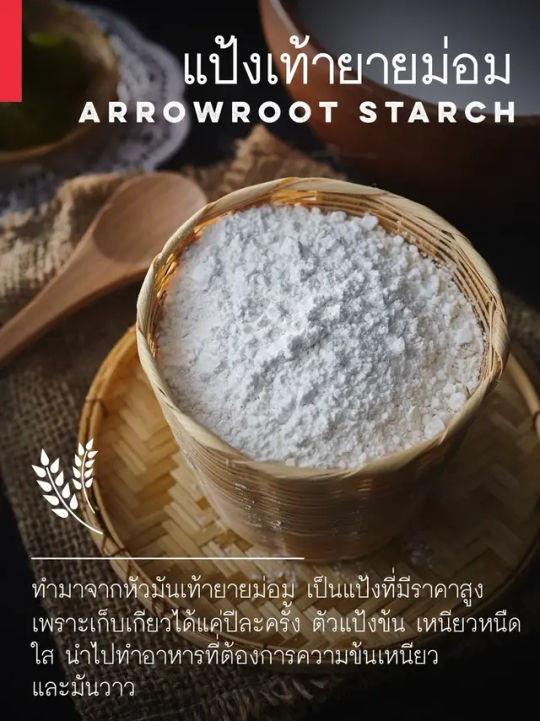
แป้งเท้ายายม่อม

เมนูที่ทำจากแป้งเท้ายายม่อม
6. แป้งถั่วเขียว (Mung bean Starch)
แป้งถั่วเขียว ทำมาจากเมล็ดถั่วเขียว เป็นผงสีขาว เนื้อแป้งสากมือเล็กน้อย ตัวแป้งเมื่อสุกแล้วจะมีลักษณะใสคล้ายกับวุ้น มีความมันเงา เมื่อพักให้เย็นตัวลงก็จะจับตัวเป็นก้อนแข็งแต่เด้ง อยู่ตัว
เมนูที่ทำจากแป้งถั่วเขียว ได้แก่ อาหารที่มีความอยู่ตัว อย่าง ตะโก้ ซ่าหริ่ม ลอดช่องแก้ว ขนมลืมกลืน
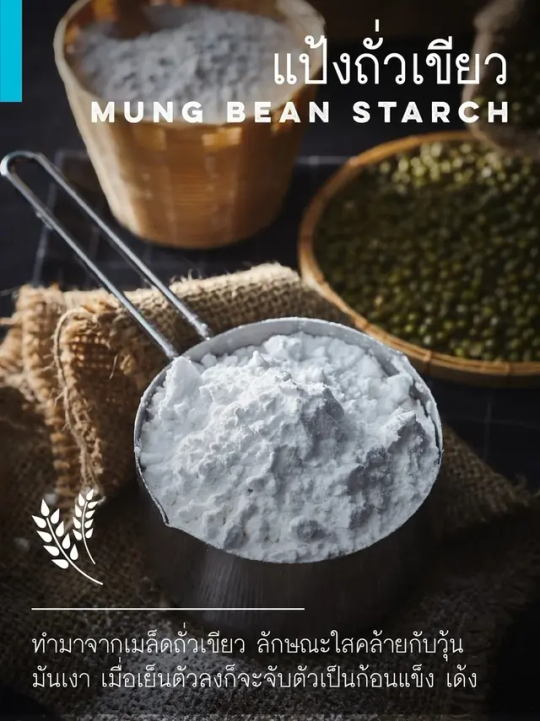
แป้งถั่วเขียว

เมนูที่ทำจากแป้งถั่วเขียว
7.1. แป้งสาลีสำหรับทำขนมปัง (Bread Flour / Hard Flour)
แป้งสาลีสำหรับทำขนมปัง ลักษณะเป็นผงสีขาวนวล เมื่อเอามือจับดูเนื้อจะค่อนข้างหยาบ ทำมาจากข้าวสาลีชนิดหนัก มีปริมาณโปรตีน 12-13%
เมนูที่ทำจากแป้งสาลีทำขนมปัง ได้แก่ โดนัทยีสต์ ปาท่องโก๋ โรตี พิซซ่า หรือเมนูทำขนมปังต่างๆ เพราะแป้งชนิดนี้จะดูดซับน้ำได้ดี มีความเหนียวและยืดหยุ่นดี

แป้งสาลีสำหรับทำขนมปัง

เมนูที่ทำจากแป้งสาลีทำขนมปัง
7.2. แป้งสาลีอเนกประสงค์ (All purpose Flour)
แป้งสาลีอเนกประสงค์ เนื้อแป้งจะละเอียดกว่าแป้งสาลีชนิดที่ใช้ทำขนมปังเล็กน้อย ราคาถูกกว่า ทำมาจากข้าวสาลีชนิดหนักและชนิดเบาผสมกัน มีปริมาณโปรตีน 9-10%
เมนูที่ทำจากแป้งสาลีทำอเนกประสงค์ ไม่ว่าจะเป็นอาหารและขนมต่างๆ เช่น แพนเค้ก คุ้กกี้ พาย โดนัท กะหรี่พัฟ รวมทั้งยังสามารถนำไปผสมน้ำเพื่อชุบอาหารต่างๆ ก่อนนำไปทอด

แป้งสาลีอเนกประสงค์

เมนูที่ทำจากแป้งสาลีทำอเนกประสงค์
7.3. แป้งสาลีสำหรับทำเค้ก (Cake Flour / Soft Flour)
แป้งสาลีสำหรับทำเค้ก บางคนอาจเรียกว่าแป้งเค้ก เนื้อแป้งมีสีขาวนวล และมีความเนียนละเอียดกว่าแป้งสาลีชนิดอื่น ๆ ดูดซับน้ำไม่ค่อยดี ไม่ค่อยเหนียวเมือเทียบกับแป้งทำขนมปัง ทำมาจากข้าวสาลีชนิดเบา มีปริมาณโปรตีน 6-9%
เมนูที่ทำจากแป้งสาลีสำหรับทำเค้ก สามารถนำไปทำขนมเค้กทุกชนิด ส่วนเมนูที่ทำจากแป้งสาลีสำหรับทำเค้ก ได้แก่ ขนมปุยฝ้าย ขนมกลีบลำดวน ขนมสาลี่
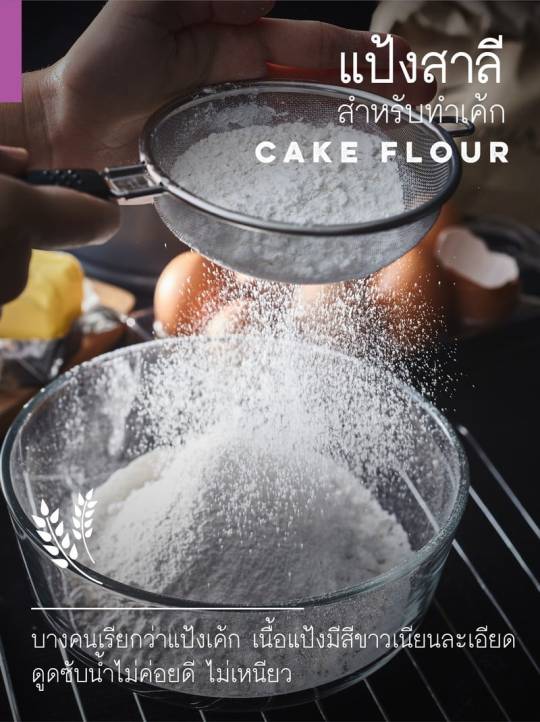
แป้งสาลีสำหรับทำเค้ก

เมนูที่ทำจากแป้งสาลีสำหรับทำเค้ก
8. แป้งมันฮ่องกง (Potato starch)
แป้งมันฮ่องกง ชื่อนี้อาจจะไม่ค่อยคุ้นหู เป็นแป้งที่ทำจากมันฝรั่ง ตัวแป้งเมื่อสุกแล้วจะมีความเหนียวข้น สีใสกว่าแป้งมันสำปะหลังหรือแป้งข้าวโพด ข้อดีของแป้งมันฮ่องกงจะมีความเหนียวไม่คืนตัว แม้จะเย็นตัวลงแล้วก็จะคงความเหนียว
เมนูที่ทำจากแป้งมันฮ่องกง ส่วนใหญ่มักจะเป็นเมนูอาหาร อย่าง ราดหน้า เป็นแป้งที่คนจีนนิยมใช้ในการทำอาหาร
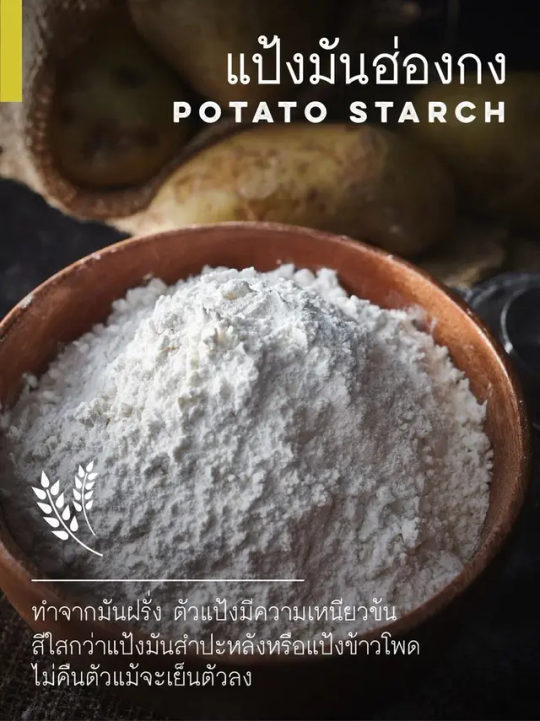
แป้งมันฮ่องกง
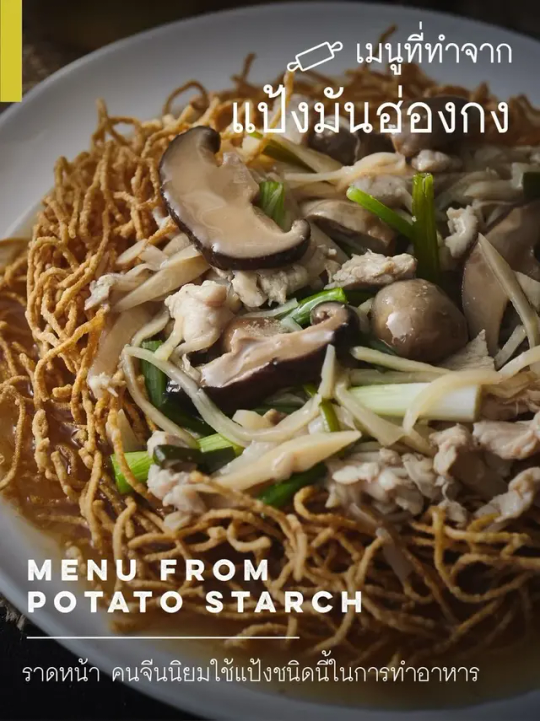
เมนูที่ทำจากแป้งมันฮ่องกง
แป้งข้าวเจ้า , Rice flour , แป้งข้าวเหนียว , Glutinous flour , แป้งมันสำปะหลัง , Tapioca starch , Cassava starch , แป้งข้าวโพด บดละเอียด , Corn starch , แป้งข้าวโพด บดหยาบ , Corn Meal , แป้งเท้ายายม่อม , Arrowroot Starch , แป้งถั่วเขียว , Mung bean Starch , แป้งสาลีสำหรับทำขนมปัง , Bread Flour , Hard Flour , แป้งสาลีอเนกประสงค์ , All purpose Flour , แป้งสาลีสำหรับทำเค้ก , Cake Flour , Soft Flour , แป้งมันฮ่องกง , Potato starch , Types Of Flour

Cr. http://www.thaikasetsart.com/ , https://www.wongnai.com/food-tips/types-of-flour ,
#แป้งข้าวเจ้า#Rice flour#แป้งข้าวเหนียว#Glutinous flour#แป้งมันสำปะหลัง#Tapioca starch#Cassava starch#แป้งข้าวโพด บดละเอียด#Corn starch#แป้งข้าวโพด บดหยาบ#Corn Meal#แป้งเท้ายายม่อม#Arrowroot Starch#แป้งถั่วเขียว#Mung bean Starch#แป้งสาลีสำหรับทำขนมปัง#Bread Flour#Hard Flour#แป้งสาลีอเนกประสงค์#All purpose Flour#แป้งสาลีสำหรับทำเค้ก#Cake Flour#Soft Flour#แป้งมันฮ่องกง#Potato starch#แป้งทำอาหาร มีกี่ชนิด#Types Of Flour
2 notes
·
View notes
Text



[It's pretty much potato starch... You own nothing? Did you get the joke?]
#s27e01 sandwiches spaetzle and wings#guy fieri#guyfieri#diners drive-ins and dives#potato starch#joke
2 notes
·
View notes
Text
Let's check in on science today and

huh. okay then:
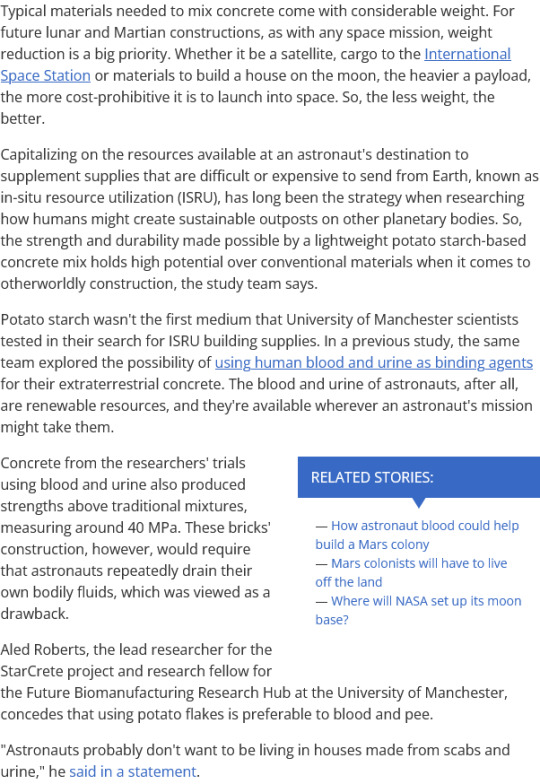
Astronauts probably don't want to be living in houses made from scabs and urine.
Science says so.
#my next d&d villain is living in a house made of scabs and urine#honestly this is a really interesting concrete with applications well beyond extraterrestrial construction#but also ew#potato starch#concrete#engineering#space#space news#science#science news#news you can use (for horrifying construction)
16 notes
·
View notes
Photo

Behbeh
#happy thanksgiving#canadian#canada#canadian thanksgiving#traditions#molson#moslon canadian#poutine#turkey#french fries#delicious#gravy#gravy boat#potato starch#potato#cheese curds#cartoon#teddy bear#illustration#dailybehbeh#behbeh#cute#stuffed animal#trending#humor#hilarious#adorable#polar bear#raccoon#art
28 notes
·
View notes
Text
Bluecraft Agro: Leading Starch Manufacturers in India for Food Grade Solutions
Bluecraft Agro stands out among starch manufacturers in India, offering premium food grade starch for diverse applications. Their innovative processing ensures the highest quality starch, perfect for use in food products requiring enhanced texture and stability. As one of the top starch manufacturers in India, Bluecraft Agro ensures that their food grade starch meets stringent safety standards, catering to the growing demand for natural ingredients. With a commitment to sustainability, they produce eco-friendly starches derived from maize, tapioca, and other plants. Starch manufacturers in India like Bluecraft Agro are setting new benchmarks for quality and innovation in the food industry.
#food grade starch#starchmanufacturer#bluecraftagro#maize starch#manufacturer#specialty starch brands#corn starch#ingredientsforahappylife#bluecraft#corn starch manufacturers in gujarat#maize starch supplier#food starch#potato starch
0 notes
Text

Lukash is the potato starch king.
0 notes
Text
Potato Starch Prices Trend | Pricing | Database | News | Index | Chart

Potato Starch Prices have shown notable fluctuations in recent years, influenced by a myriad of factors that include agricultural conditions, market demand, and global trade dynamics. As a versatile product widely used in food processing, paper manufacturing, and textiles, potato starch is subject to market conditions that can vary significantly year by year. Key factors impacting its price include weather patterns that affect potato yields, shifts in consumer preferences, and changes in the cost of production inputs such as labor and energy. For instance, adverse weather conditions in major potato-growing regions can lead to reduced harvests, thereby constraining the supply of raw potatoes used for starch production. This reduction in supply, coupled with steady or increasing demand, naturally drives up prices.
In recent years, there has been a growing demand for gluten-free and plant-based food products, contributing to an increased demand for potato starch as an alternative to wheat-based starches. This trend is particularly strong in North America and Europe, where consumers are increasingly seeking out healthier and more sustainable food options. The food industry's shift towards cleaner labels and natural ingredients has also played a significant role, as potato starch is often used as a thickener and stabilizer in various processed foods, including soups, sauces, and ready-to-eat meals.
Get Real Time Prices of Potato Starch: https://www.chemanalyst.com/Pricing-data/potato-starch-1486
The pandemic led to labor shortages, transportation challenges, and logistical bottlenecks, all of which contributed to increased production and distribution costs. These factors, combined with fluctuating demand as various regions experienced lockdowns and changes in consumption patterns, created an unpredictable market environment. In addition, geopolitical tensions and trade policies can influence the import and export dynamics of potato starch. Tariffs, trade agreements, and regulatory changes can either facilitate or hinder the movement of potato starch across borders, thus affecting its price on the global market.
Another important aspect is the cost of raw materials and energy, which significantly impacts the production cost of potato starch. Energy prices, particularly those of oil and gas, have a direct effect on the cost of running agricultural machinery and processing plants. When energy prices rise, the cost of producing potato starch increases, which can lead to higher prices for the end product. Similarly, fluctuations in the prices of fertilizers and other agricultural inputs can also affect the cost of potato production, subsequently influencing potato starch prices.
Technological advancements and innovations in the starch extraction process have the potential to alter the cost structure of potato starch production. Improved extraction techniques can enhance yield and efficiency, thereby reducing production costs and potentially stabilizing prices. Additionally, advancements in agricultural practices, such as the development of disease-resistant potato varieties and more effective pest control methods, can contribute to more stable and predictable potato yields, helping to mitigate some of the volatility in potato starch prices.
Consumer trends also play a crucial role in shaping the market for potato starch. As consumers become more health-conscious and environmentally aware, there is a growing preference for products that are perceived to be natural and sustainable. Potato starch fits well into this trend, being a plant-based and minimally processed ingredient. This growing consumer preference can drive demand and influence prices. On the other hand, competition from other starches, such as corn and tapioca, can affect potato starch prices. If the prices of alternative starches decrease, it may lead to a corresponding decrease in demand for potato starch, putting downward pressure on its price.
Seasonal variations also have a notable impact on potato starch prices. The harvesting season for potatoes typically influences the availability of raw material for starch production. During harvest periods, there is an abundance of potatoes, which can lead to lower prices due to increased supply. Conversely, during the off-season, limited availability can drive prices up. The interplay of these seasonal factors contributes to the cyclical nature of potato starch pricing.
In conclusion, potato starch prices are influenced by a complex interplay of factors including agricultural conditions, market demand, production costs, technological advancements, consumer trends, and global trade dynamics. Understanding these factors is essential for stakeholders in the potato starch market, from farmers and producers to food manufacturers and consumers. By closely monitoring these variables, stakeholders can better anticipate price trends and make informed decisions to navigate the ever-evolving market landscape. As the market continues to evolve, ongoing analysis and adaptation will be crucial to managing the challenges and opportunities associated with potato starch prices.
Get Real Time Prices of Potato Starch: https://www.chemanalyst.com/Pricing-data/potato-starch-1486
Contact Us:
ChemAnalyst
GmbH - S-01, 2.floor, Subbelrather Straße,
15a Cologne, 50823, Germany
Call: +49-221-6505-8833
Email: [email protected]
Website: https://www.chemanalyst.com
#Potato Starch#Potato Starch Price#Potato Starch Prices#Potato Starch Pricing#Potato Starch News#Potato Starch Price Monitor
0 notes
Text
0 notes
Text

V/GF Strawberry Cake
#vegan#gluten free#strawberry#cake#food#layer#birthday#dessert#recipe#pink#dairy free#frosting#egg free#summer#berries#fruit#almond flour#almond#nuts#potato starch#tapioca free#minimalistbaker
197 notes
·
View notes
Text


Easy Vegan Potato Mochi (Sweet or Salty Snack)
#vegan#snacks#appetizer#mochi#potato#potato starch#nori#vegan butter#soy sauce#mirin#coconut sugar#sesame oil#sea salt
122 notes
·
View notes
Text

GF King Cake (via Let Them Eat GF Cake)
#gluten free#gf food#gluten free foods#dessert#cakes#flour mix#potato starch#white rice flour#tapioca starch#xanthan gum#cream cheese#cinnamon#mardi gras#holidays#letthemeatgfcake
56 notes
·
View notes
Text
Potato Starch market Report | Global Forecast From 2023 To 2030 With Top Key Players

The Global Potato Starch market size was reasonably estimated to be approximately USD 8200 Million in 2023 and is poised to generate revenue over USD 12530 Million by the end of 2030, projecting a CAGR of around 6.20% from 2023 to 2030.
In order to extract the starch grains, potatoes are crushed to release them. The starch grains are then extracted from the solution and dried until they have a light, powdery consistency. Because of its flour-like consistency, it is a common ingredient in many recipes. Leucoplast-containing potato root tuber cells are where the starch is taken from the plant. It's a multipurpose ingredient that works well in baking, cooking, and food processing.
Because potato starch is a versatile ingredient that may thicken and enhance the texture of a wide range of meals, including puddings, baked goods, and sauces, the market for it is growing.As a supplement, it may also help with digestion, boost immunity, and control blood sugar, among other possible health advantages.
Because of its enticing texture, flavor, and possible health benefits, starch has become an essential ingredient in many innovative products developed by the food and beverage industry. The rising demand for organic food is driving growth in the worldwide starch market.
In the paper industry, potato starch is widely employed, mostly as an adhesive, surface sizer, and bonding agent in a variety of products such coatings, laminated grades, and corrugated boards. Starch is a necessary component of numerous paper grades since it is consumed by weight in the processes of papermaking and paper conversion after cellulose fiber and mineral pigments.
The market for potato starch is expected to grow due to a number of factors, including the growing popularity of processed and convenience foods, the growing demand for potato starch in the paper industry, the rising prevalence of food allergies, including celiac disease, and the growing demand for functional foods.
Get Sample Report: -
Updated Version 2024 is available our Sample Report May Includes the:
Scope For 2024
Brief Introduction to the research report.
Table of Contents (Scope covered as a part of the study)
Top players in the market
Research framework (structure of the report)
Research methodology adopted by Worldwide Market Reports
Moreover, the report includes significant chapters such as Patent Analysis, Regulatory Framework, Technology Roadmap, BCG Matrix, Heat Map Analysis, Price Trend Analysis, and Investment Analysis which help to understand the market direction and movement in the current and upcoming years.
Leading players involved in the Potato Starch Market include:
"Cargill, Incorporated (U.S), Pepees S.A(Poland), Ingredion, Incorporated (U.S), KMC a.m.b.a (U.S), AGRANA Beteiligungs -AG (Austria), Tereos (France), Avebe (Netherlands), Emsland Group (Germany), Novidon, Roquette (France), Tata & Lyle (UK), VIMAL PPCE (Ukraine), Lyckeby (Sweden), Radchen USA (US), AKV Langholf (Denmark), and Other Key Players".
Market Driver:
One significant market driver for potato starch is its rising popularity as a gluten-free alternative in the food industry. With the increasing prevalence of gluten-related disorders and the growing health consciousness among consumers, there's a heightened demand for gluten-free products. Potato starch serves as an excellent substitute for wheat-based thickeners and binders in gluten-free formulations, making it a preferred choice for manufacturers aiming to cater to this expanding consumer segment. As a result, the demand for potato starch is expected to continue its upward trajectory, driven by the gluten-free trend.
Market Opportunity:
An emerging market opportunity lies in the utilization of potato starch in biodegradable packaging materials. With the growing environmental concerns and the push towards sustainable packaging solutions, there's a rising demand for biodegradable and compostable packaging materials. Potato starch-based bioplastics offer a promising alternative to conventional petroleum-based plastics, providing similar functionality while being eco-friendly and renewable. The development of innovative packaging solutions using potato starch presents a significant opportunity for market players to tap into the burgeoning sustainable packaging market.
If You Have Any Query Potato Starch Market Report, Visit:
Segmentation of Potato Starch Market:
By Type
Native
Modified
By Nature
Conventional
Organic
By Application
Food & Beverage
Textile & Paper Industry
Pharmaceutical Industry
Animal Feed
By Function
Thickener
Binder
Stabilizer
Disintegrant
By Regions: -
North America (US, Canada, Mexico)
Eastern Europe (Bulgaria, The Czech Republic, Hungary, Poland, Romania, Rest of Eastern Europe)
Western Europe (Germany, UK, France, Netherlands, Italy, Russia, Spain, Rest of Western Europe)
Asia Pacific (China, India, Japan, South Korea, Malaysia, Thailand, Vietnam, The Philippines, Australia, New Zealand, Rest of APAC)
Middle East & Africa (Turkey, Bahrain, Kuwait, Saudi Arabia, Qatar, UAE, Israel, South Africa)
South America (Brazil, Argentina, Rest of SA)
Effective Points Covered in Potato Starch Market Report: -
Details Competitor analysis with accurate, up-to-date demand-side dynamics information.
Standard performance against major competitors.
Identify the growth segment of your investment.
Understanding most recent innovative development and supply chain pattern.
Establish regional / national strategy based on statistics.
Develop strategies based on future development possibilities.
Purchase This Reports: -
About Us:
We are technocratic market research and consulting company that provides comprehensive and data-driven market insights. We hold the expertise in demand analysis and estimation of multidomain industries with encyclopaedic competitive and landscape analysis. Also, our in-depth macro-economic analysis gives a bird's eye view of a market to our esteemed client. Our team at Pristine Intelligence focuses on result-oriented methodologies which are based on historic and present data to produce authentic foretelling about the industry. Pristine Intelligence's extensive studies help our clients to make righteous decisions that make a positive impact on their business. Our customer-oriented business model firmly follows satisfactory service through which our brand name is recognized in the market.
Contact Us:
Office No 101, Saudamini Commercial Complex,
Right Bhusari Colony,
Kothrud, Pune,
Maharashtra, India - 411038 (+1) 773 382 1049 +91 - 81800 - 96367
Email: [email protected]
#Potato Starch#Potato Starch Market#Potato Starch Market Size#Potato Starch Market Share#Potato Starch Market Growth#Potato Starch Market Trend#Potato Starch Market segment#Potato Starch Market Opportunity#Potato Starch Market Analysis 2022#US Potato Starch Market#Potato Starch Market Forecast#Potato Starch Industry#Potato Starch Industry Size#china Potato Starch Market#UK Potato Starch Market
0 notes